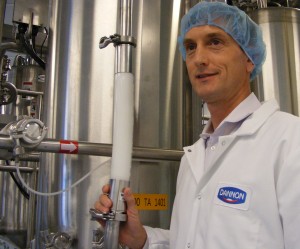Yogurt culture

Less than 10 percent of U.S. households consume yogurt at least once a week.
It may be a tough number for a yogurt company to swallow, but Gustavo Valle intends to change that figure for The Dannon Co.
The CEO”™s plan includes a new stainless-steel jungle of a test facility built within its Greenburgh headquarters.
Part of a $9 million capital investment to more closely tie the company”™s research and development operations with sourcing and supplier development, Dannon”™s approximately 9,000-square-foot Discovery and Innovation Center was designed to bring home the product development process.

The center also is designed to strengthen Dannon”™s position in an approximately $5-billion yogurt market that is projected to grow to $11 billion over the next few years.
Valle said the facility opening is an important step “because one of the key drivers to convince consumers to eat yogurt is to bring innovation in new product and package design.”
“We”™ve been in Westchester for 25 years and the brain of the company is here,” he said. “We”™ve had the arms mixing the products in Texas, which is not an efficient way to work because our marketing team is thinking about ideas here.”
Founded in 1942 in the U.S., Dannon”™s history and growth are rooted in product evolution.

In the 1940s, all that existed was “plain, tart yogurt that was pretty tough to eat,” said Michael Neuwirth, Dannon”™s senior director of public relations. “You had to tolerate it. Then five years later, the founder of the company said, ”˜We can change that, we can innovate, we can do fruit on the bottom.”™ What a revolutionary concept. It actually exploded sales.”
In 1955, a low-fat product was introduced. In 1982, the company launched “mini cups” for kids. With the introduction of aspartame in 1988, the yogurt maker created a “light” product. In 2006, it launched its line of probiotic dairy products. (Dannon settled for $35 million a class-action lawsuit brought against the company for advertising and labeling on its probiotic brands, Activia and DanActiv.) In 2008, the company doubled the calcium in its product mix to create Dan-o-nino for kids. Two years later, Dannon joined the competitive and fast-growing market for Greek-style yogurts
“Today, of every dollar spent on yogurt, almost 25 percent is Greek,” Neuwirth said. “I think you”™ll continue to see growth in Greek and in specialty yogurts.”
“The category of yogurt and the history of our company have really been fueled by information and discovery,” Neuwirth said.
And by consumer trends.
Groupe Danone, the French parent company of The Dannon Co., in December acquired YoCream International for $103 million to expand its product offerings into the frozen yogurt market.
Neuwirth said the company has established “an away-from-home business unit” to reach consumers “wherever people choose to eat, which is increasingly out of the home.”
The new research and development facility, built by C.W. Brown Inc. of Armonk, is on the ground floor of Dannon headquarters in space formerly occupied by finance department staff. Real-time analyses ”“ examining details as simple as how a piece of fruit is sliced – allow major modifications in the product development process.
Photographs by Kelly Liyakasa